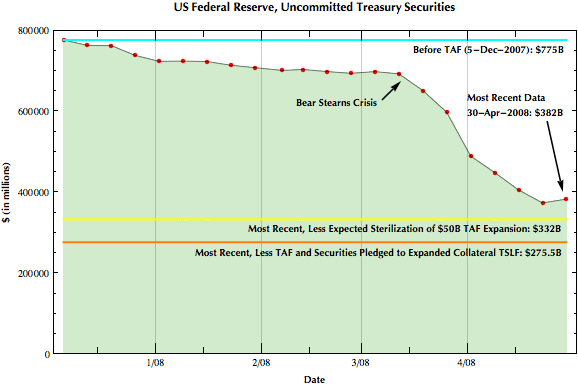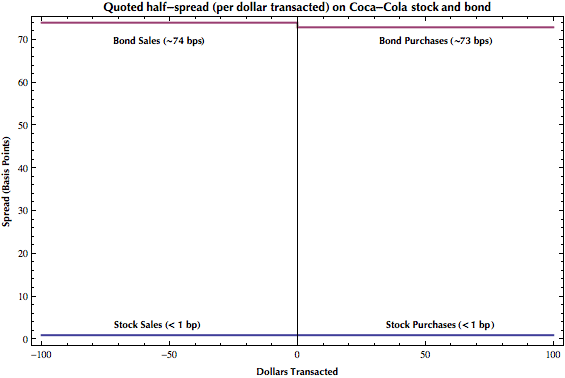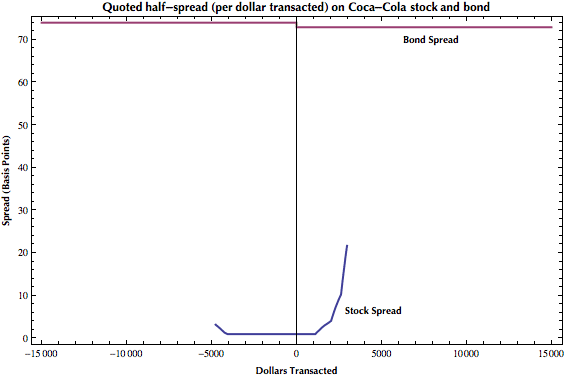Let’s not write the Fed a blank check
Last week, the Fed decided to ask Congress for the right to pay interest on bank reserves. (Hat tip Barry Ritholtz, see also William Polley, Mark Thoma, Brad DeLong) This is a very big deal.
Don’t be misled into thinking that the Fed’s proposal is just some arcane, technocratic change. The Federal Reserve is asking taxpayers for a big pile of signed, blank checks. That’s far too much power to put in the hands of a quasipublic organization with little democratic accountability. This authority should not be granted without some strong strings attached.
First, some background. There is a trend among central banks to move from old-fashioned, fractional-reserve banking to a system whereby interest rates are managed via a “channel” or “corridor”, and under which fixed reserve requirements might be dispensed with entirely. The basic idea is simple. The Fed currently manages interest rates indirectly, by manipulating the supply and demand for cash in the banking system. But the Fed could adopt a more direct approach. It could choose two interest rates, a “floor rate” at which the Fed would stand ready to borrow funds, and a “ceiling rate” at which the Fed would stand ready to lend. As long as there is no stigma attached to transacting with the Fed, banks would never lend for less than the floor rate or borrow for more than the ceiling rate. The interbank interest rate would necessarily lie within a “corridor” defined by these two interest rates. The Fed would continue to adjust the money supply to keep interest rates somewhere inside the desired range. But the corridor would serve as a fail-safe. When banks have more cash than would be consistent with the policy interest rate, they would lend the excess money back to the Fed, causing it to disappear in a poof of green smoke. When banks have too little cash, they would borrow more into existence, until the quantity on hand becomes consistent with the Fed’s desired interest rate. The level of borrowing from or lending to the Fed would provide feedback, telling central bankers whether they need to add or remove cash from the banking system to achieve their targetted interest rate, usually at the center of corridor.
A corridor system would represent a meaty change to how central banking is done in the US, but the approach seems to work okay in other countries. Advantages for central banks include more robust control of short-term rates, and the ability to fine-tune monetary policy by altering the “spread” between the central bank borrowing and lending rates without changing the core interest rate. A disadvantage, from taxpayers’ perspective, is that the loss of zero-interest reserves amounts to a stealth tax cut for banks. On the back of my napkin, the cost to taxpayers would be between $190M to $530M per year if the level of reserves is unchanged. (I’m assuming “floor rates” between 1.75% and 4.75% against reserves of $11B). The Wall Street Journal reports estimates of $150M and $280M per year. If one assumes that corridor interest rates will roughly match the Treasury’s average cost of financing over time, and that the Fed invests reserves in Treasuries, then the total cost of the program in NPV terms would be the value of the current (interest-free) reserves. This amounts to a one time cost of about $11 billion. A more serious drawback is that a channel system paves the way for the getting rid of reserve requirements entirely, which seems a perverse thing to do in a credit crisis caused by too much leverage. But reserve requirements have already been eviscerated, and nothing prevents regulators from maintaining or strengthening reserve requirements in a channel system.
So far, so good, then. As long as the Fed is conducting ordinary monetary policy, switching to a channel system offers modest benefits at a modest cost to taxpayers. But the Fed’s monetary policy has not been ordinary at all lately. In fact, it’s been quite extraordinary. It is in the context of this extraordinary policy that the Fed has asked Congress to accelerate its authority to implement a channel system, and it is in the context of this extraordinary policy that we must consider the change.
The core of the Fed’s new exuberance is a willingness to enter into asset swaps with banks. The Fed lends safe Treasury securities to banks, and accepts as collateral assets that private markets consider dodgy or difficult to value. (This is the direct effect of the Fed’s TSLF program, and the net effect of TAF and other lending arrangements that the Fed sterilizes in order to hold its interest rate target.) In doing so, the Fed puts taxpayer funds at risk. If a bank that has borrowed from the Fed runs into trouble, the Fed would face an unappetizing choice: Orchestrate a bail-out, or permit a failure and accept collateral of questionable value instead of repayment. Either way, taxpayers are left holding the bag.

In December, the Fed had $775 worth of Treasury securities. That stock will soon have dwindled to $300B, give or take. The difference, about $475B, represents an investment by the central bank in risky assets of the US financial sector.
$475B is an extraordinary sum of money. It is as if the Fed borrowed more than $1500 from every man, woman, and child in the United States, and invested that money on our behalf in Wall Street banks that private financiers were afraid to touch. For bearing all this risk, if things work out well, taxpayers will earn about what they would have earned investing in safe government bonds. If things don’t work out well, the scale of the losses is hard to predict. The Fed will claim to have done “due diligence” on its loans, to have valued collateral conservatively, and will point to strength of bank guarantees and the enormous diversity of collateral assets to convince us that its actions are safe and prudent. But rating agencies made the same claims about AAA CDO tranches, and turned out to have been mistaken. Correlations often tend towards one when asset values fall sharply. Central bankers struggling to manage day-to-day crises in financial markets might cut corners when trying to value complex securities. They might find it convenient to err on the side of optimism, as the ratings agencies did, albeit for very different reasons. And even if the Fed is cautious and sober-minded, are we sure that central bankers can value these assets more accurately than private investors?
If the Fed were to blow through the rest of its current stock of Treasuries, it would have invested more than $2500 for every man, woman, and child in America. Public investment in the financial sector would have exceeded the direct costs to date of the Iraq War by a wide margin. Would that that be enough? If not, how much more? Just how large a risk should taxpayers endure on behalf of companies that arguably deserve to fail, to prevent “collateral damage”? Have we considered other approaches to containing damage, approaches that shift costs and risks towards those who benefited from bad practices, rather onto the shoulders of taxpayers and nominal-dollar wage earners? Does this sort of policy choice belong within the purview of an independent central bank?
Now I don’t actually mean to be too harsh. Putting aside the years of preventable foolishness that got us here, in the new day that began last summer, a crisis emerged that had to be managed and the Fed was the only organization capable of stepping up to the plate. I don’t love the decisions that were made, but decisions did have to be made, and there weren’t very good options. But now we have a moment to reflect. If the credit crisis flares hot and bright again, how much more citizen wealth should be put at risk before other policy options are considered? That’s not a rhetorical question: We need to choose a number, a figure in dollars. My answer would be something north of zero, but not more than the roughly $300B stock of Treasuries that remains on the Fed’s balance sheet. But this is a decision that Congress needs to make.
And what does all this have to do with the question that will soon be put before the Congress, whether the Fed should be permitted to pay interest on deposits? Everything, as it turns out. Suppose the Fed decides it wants to swap more than the $300B in Treasury securities it currently has available in order to support the financial system. Given its current tools and practices, the Fed would have to print money in order to buy more Treasuries to swap. But if it did that, the extra cash would drive interest rates below the Fed’s target level, quite likely provoking inflation. The Fed cannot simultaneously swap away more than its existing stock of Treasuries and satisfy its legal mandate to promote price stability, unless it resorts to something weird.
But suppose Congress gives the Fed the authority to pay interest on reserves. Suddenly the Fed can print cash to buy all the Treasuries it wants to swap for troubled assets. When banks find they have more cash than they need, they lend the money back to the Fed, collecting the “floor” interest rate and removing the currency from circulation. Since interest rates can be held to any level by adjusting the “corridor”, the Fed would retain the flexibility to respond to inflation. At the same time, it would be able print cash in any amount that it pleases — “to infinity and beyond!” — in order to fund asset swaps (or outright purchases) at taxpayers’ risk. This strikes me as a delegation of Congressional authority that would not only be undesirable, but arguably unconstitutional.
So, should we simply refuse the Fed’s request? Probably not. Brad DeLong makes an excellent point:
The Fed may also want to raise the general level of interest rates in order to fight inflation–which requires that it sell its Treasuries for safe bank reserves rather than temporarily swap them for risky MBSs.
The Fed is already rubbing pretty close to its “balance sheet constraint”. If, after exposure to gamma radiation from televised images of food riots, Ben Bernanke were suddenly transformed into The Incredible Volcker, he might lack the tools he’d need to jack rates up into the muscular high teens, unless he’s given this new authority. So what should we do? James Hamilton has an answer:
Congress has a quite proper role in determining the magnitude of the fiscal risk that the Fed opts to assume… [A] statutory limit on the non-Treasury assets that the Fed is allowed to hold might make sense. Perhaps the outcome of a public debate on this issue would be a decision that the Fed needs the power to lend to private borrowers even more than the $800 billion or so limit that it would run into from completely swapping out its entire portfolio… Or perhaps after deliberations, Congress would decide that the business of swapping Treasury debt for private sector loans is one that is better run by the Treasury rather than the Federal Reserve.
I agree. I think that Congress should grant the Fed’s request, but it should simultaneously impose constraints on the composition of the Fed’s balance sheet that cannot be violated without express legislative consent. This will be a complicated exercise, unfortunately. Besides government debt, central banks quite ordinarily hold precious metals and foreign exchange, and limitations on non-Treasury assets will have to take this into account. Plus, restrictions would have to be written carefully to apply to off-balance sheet arrangements such as TSLF, and contingent liabilities like the insidious reverse MBS swap proposal. Finally, Congress must consider restrictions on the Fed’s ability to enter into derivative positions, whether directly or indirectly via special purpose entities, including how the bank’s existing derivative book should be managed and whether the bank should or should not guarantee the liabilities of current Fed-affiliated SPEs.
Congress might also limit the quantity of reserves on which the Fed will be permitted to pay interest.
The Fed can retain full independence for the purpose of conducting ordinary monetary policy, exchanging government debt for cash and vice-versa. But if the central bank wants to put ever greater quantities of public money at risk, it will have to accept a lot more public supervision. If the prospect of intrusive oversight is too much for the Fed, then, as James Hamilton hints, perhaps the roles of central bank and macroeconomic superhero should be moved to separate boxes on the organizational chart. If we are not careful, the next bank requiring a taxpayer bailout may be the Federal Reserve system itself.
- 12-May-2008, 2:20 a.m. EDT: Changed a “fine” to “okay” to avoid having “fine” too close to “fine-tune”.



